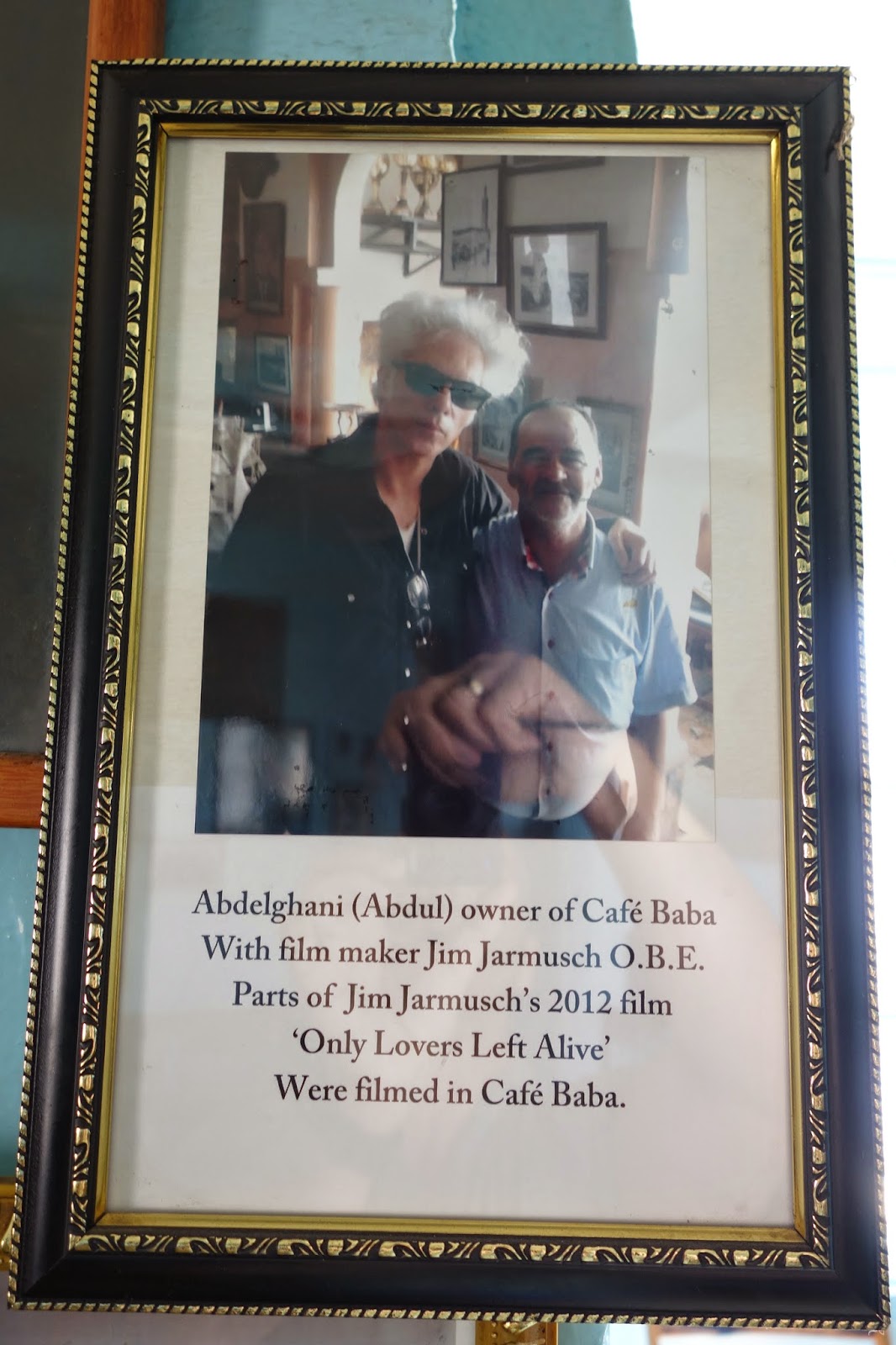Dr. Plotnick’s Moroccan Cat Adventure – Day 10 – Our Last Day in Morocco
We headed toward the Grand Socco, then turned left and visited St. Andrew’s Church.
It’s a bit of an odd site in Morocco, as it fuses Moorish decoration, an English country churchyard, and a Scottish flag, which features the cross of St. Andrew. The church has a peaceful graveyard made colorful by the purple flowers that have fallen from the trees.
I spotted a friendly tomcat in the churchyard and I gave him some dry food that I was carrying with me.

I found Yassine, and he gave us a tour. The church itself was pretty non-descript, but cute.
Since we were close by the Cinema Rif, we decided to pop in. Yesterday we photographed the outside. The theater is from 1938, and it was recently renovated. Inside there are old Spanish film fliers and old faded photos that harken back to another era in Tangier.
Time to go into the medina. We went through the main gate, and I immediately saw this handsome cat, situated almost right on the edge of the sun’s shadow. Made for a nice photo.
In the medina, we headed up the main street, the Rue es Siaghin, known as “The Silversmith’s Street”, although most of the silversmiths have been replaced by souvenir shops. The Rue es Siaghin connects the Grand Socco with the Petit Socco. Halfway along the street, we passed the Church of the Immaculate Conception, which was built in 1880 by a Franciscan missionary.
It is the only church in Morocco found in the walls of a medina. The church no longer holds services. Now it is occupied by Mother Teresa’s Missionaries of Charity.
But up until the t19th century, the square was almost twice its present size. Only at the beginning of the 20th century were the hotels and cafés built up. You’d never guess, hanging out here, that this was the true heart of Tangier, and a broad mix of people – Christians, Jews, Muslims, Moroccans, Europeans, and Americans – would gather here daily. Seating in the Petit Socco is divided among three main cafes – Tingis, Central, and Fuentes. I suppose the Grand Central Café is the main anchor.
It was in the alleys behind the Socco that the straight and gay brothels were concentrated. William S. Burroughs used to hang out around the square in the heyday of the “International City, when Arab and Spanish sexuality was an easily exploited attraction. “I get averages of ten very attractive propositions a day”, he wrote to Allen Ginsberg.
Finding your way to the Kasbah is fairly easy. If you’re going uphill you’re heading the right way.
As we meandered uphill, we stumbled upon Rue Sidi Hosni. This street is named after the mini palace called Sidi Hosni. The eccentric Woolworths heiress, Barbara Hutton, moved to this place in 1947, reputedly outbidding General Franco for it. They say her parties here were legendary. Here I am outside the place.
It was founded in 1943, and was popular with hippies and rock-n-rollers in the ‘70s. Apparently a lot of pot and hashish smoking went on in here. Nowadays, it’s pretty rundown inside but the posters on the wall tell of their glory days.
Just inside the gate is the Seqaya Bab el Assa, one of the largest and most beautiful fountains of the Medina, featuring exquisite zellij tiles and an ornamental wooden roof. Here’s Mark, sitting at it.
We then walked into the Kasbah square, which is often the site of snake tamers and other performers, as they try to snag money from tourists coming by ferry from Spain, which is only 20 miles away. Today there were no performers. At the end of the square is Bab el-Bhat,
 Here I am, just after putting an antibiotic eye drop in her eye. You can see she’s not liking it.
Here I am, just after putting an antibiotic eye drop in her eye. You can see she’s not liking it.
This used to be the Kasbah’s palace. The sultan’s (Moulay Ismail) former apartments now house an interesting Moroccan art museum, with mosaic floors, carpets, furniture, jewelry, ceramics, and the like.
Unfortunately, a local saw us wandering around the dead end streets and cul-de-sacs, and asked where we were going, and kinda glommed onto us and wouldn’t leave even after we said we didn’t need any help. We finally kept ignoring him and he eventually left. Grrrr.
It was an opportunity for some literary nostalgia. This dark bar has a rich history, hosting the likes of William Burroughs, Allen Ginsberg, Jack Kerouac, Paul Bowles, Jean Genet, Tennessee Williams and Federico Garcia Lorca. Burroughs wrote much of Naked Lunch in this very bar. There’s a piano in the corner
and some non-descript leather seats.
But there are photos on the wall that give a hint of past visitors, like this one of a bunch of beat writers (that’s Burroughs on the left and Ginsberg in the white pants),
The place was empty when I was there. Not sure if I was there too early, or if this is just the way Tangier is. Either way, I was glad to at least set foot inside the place where some of my favorite writers did their best work.
And that’s our Morocco trip. Ten days flew right by, and we barely scratched the surface. I wasn’t expecting to enjoy the trip as much as I did, but really, it was one of the best trips we’ve ever taken. I definitely will come back. I need to see Rabat and Casablanca. I want to explore Morocco’s four mountain ranges, and I want to ride a camel through the Sahara desert. One of the best things, for me, was the many wonderful cats that I saw, and the numerous acts of kindness bestowed upon them by the people of Morocco. I hope you’ve enjoyed the stories and the photos.



















